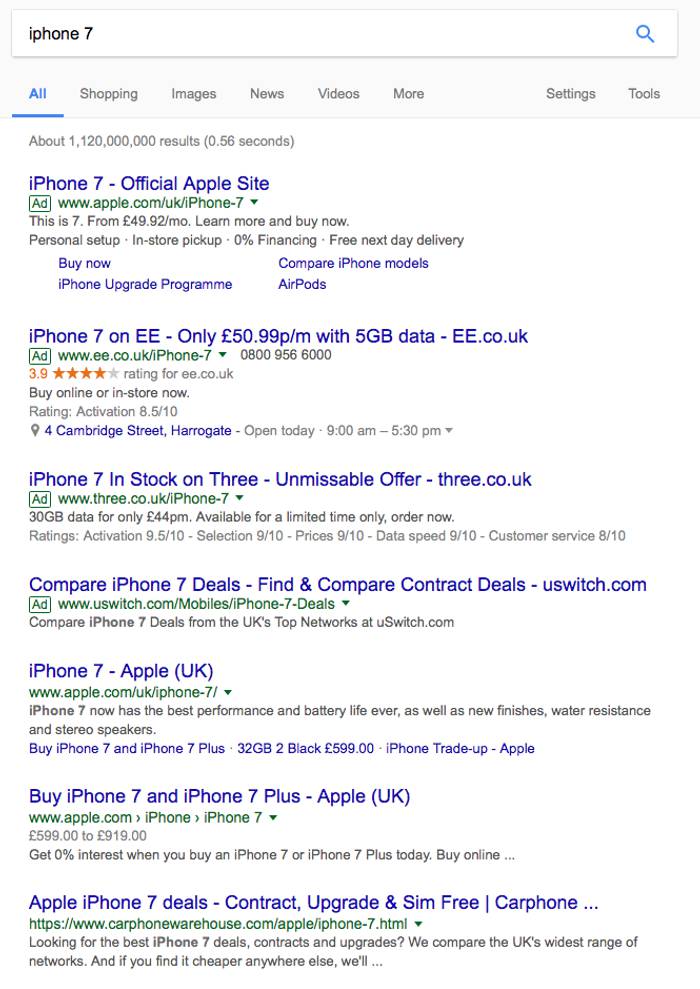It’s no secret that Google are trying to minimise the difference between a paid advert and an organic search results. Why, you ask? Well, it’s all in aid of removing that subconscious decision that consumers make when choosing where to click through to after searching for something in Google.
What’s the point?
Google’s main revenue driver by a country mile is the Google Adwords platform. Therefore, its ultimate goal is to drive as many businesses and advertisers onto using PPC, rather than them relying on the organic listing for their online visibility.
It’s elementary…
Growing number of business using PPC
+
Higher demand for better positioning
=
CPC’s are driven up
=
More revenue for Google
The problem Google have always faced
However, while the above seems like basic logic, the above model has always been completely reliant on a factor that they can’t necessarily control; you, the people who search the internet.
To increase the demand for businesses to pay more for better positioning, it must first yield results at a customer level (i.e the business paying to use PPC). This in itself is dependant though on the millions of people searching the web every second, to click on the paid adverts instead of the organic listings.
It is this control over the end user that Google have always had difficulties controlling. There is no way to force us to click on paid ads, and due to ethical reasons, they have traditionally always had to make it clear that if you do click on a paid ad, then you’re well aware that you’re doing so.
What they can do however, and do do very well, is give the business more control over what is shown in their adverts to make them more appealing to the end user. Examples of this include the ever increasing amount of extensions available, dynamic keyword insertion, increased content etc. Relevancy is key here.
Customers make decisions with their eyes.
Despite the vast amount of flexibility advertisers have within the Google Adwords platform, the biggest issue has always been eliminating the sub conscious, or sometimes conscious, decision to actively navigate away from the paid ads, and engage with the organic results. A study in 2016 by Search Engine Watch identified that 50.6% of adults couldn’t actually recognise a paid advert, with 36.2% of people saying that they did recognise an add, but don’t click on them.
It is this 36.2% that are Google’s priority. Which is why over the years, Google have made a distinguished effort to minimise the visual difference between paid ads and organic ads. Examples include removing the background colours and making the labels less obvious. Below is a good representation of the adverts over the years from SEL.
The latest change is the green ‘Ad’ label, which is now outlined with the original green colour but hosts a transparent centre and is almost identical to an organic listing as can be seen below.
Feel cheated?
So how does this help Google? The above is a good visualisation of why Google make the changes that they do. Making the ads less distinguishable means that the barrier preventing people having to make an active decision to choose paid or organic is less present, which means that they’re more likely to click on the paid ads. Combined with the more targeted messaging, and the dominance of them at the top of the SERP’s, you’re almost left with no choice in many cases.
What's next?
Expect the blending of paid ads and organic results to become even smoother throughout 2017. While I don’t think they’ll ever be able to make them ‘ad free’ so to speak, due to ethical reasons, they’ll no doubt be testing new changes to make that Ad less visible. With Google Shopping results being prioritised in certain searches, and the inclusion of them in image searches, this could be the start of Google making the 1st page completely focused on paid adverts.
Fancy a good ol' chat about the values of marketing to your business?
Drop Us a LinePost by
Project





